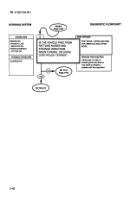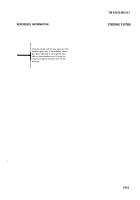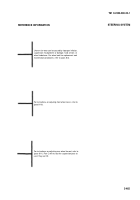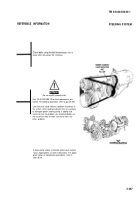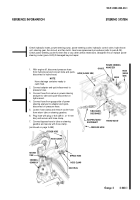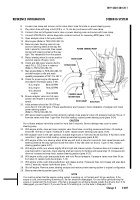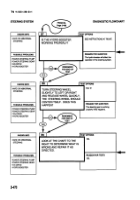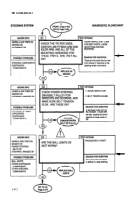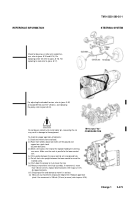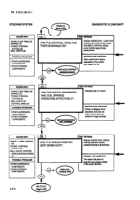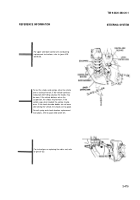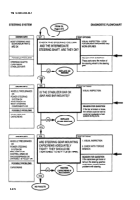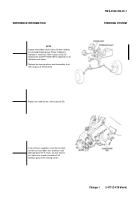TM-9-2320-280-20-1 - Page 573 of 888
TM 9-2320-280-20-1
REFERENCE INFORMATION
STEERING SYSTEM
8.
Loosen hose clamp and remove control valve return hose from tube on power steering pump.
9.
Plug return hose with plug or bolt (3/8 in. or 10 mm dia.) and secure with hose clamp.
10. Connect other end of bypass hose to tube on power steering pump and secure with hose clamp.
11.
Connect STE/ICE-R to vehicle diagnostic connector and set for measuring RPM (para. 2-43).
12.
Open analyzer valve to full open position.
13.
Start engine (Refer to TM 9-2320-280-10).
14.
Remove power steering reservoir cap
and turn steering wheel all the way left,
hold in place for 5 seconds, then repeat
process with steering wheel all the way
right. This releases air from the system.
15.
Return steering wheel to center position
and shut engine off (para. 3-44).
16.
Check and add power steering fluid to
reach FULL COLD level in reservoir
(Refer to TM 9-2320-280-10).
17.
Start engine (Refer to TM 9-2320-280-10)
and allow engine to idle and reach
operating temperature of 190° F to 230° F.
18.
Check for proper engine idle speeds
and adjust if necessary (para. 3-44).
6.2L engine
650±25 RPM
6.5L engine
700±25 RPM
6.5L detuned
engine
700±25 RPM
19.
Ensure analyzer valve is in full open
position and engine is at proper idle
speed.
20.
Initial pressure should be 150-250 psi
and a flow of 2.50-3.50 gpm. If these specifications aren't present, check installation of analyzer and check
power steering system
(Refer to TM 9-2320-280-10).
21.
With power steering system working properly, partially close analyzer valve until pressure reaches 700 psi. If
flow rate varies more than 1 gpm from the initial reading, replace power steering pump (para. 8-24).
CAUTION
Do not leave analyzer valve fully closed for more than 5 seconds. Severe damage may occur to power
steering pump.
22.
With engine at idle, close and open analyzer valve three times, recording pressure each time. All readings
should be 1300 psi or higher, if pressure is lower, replace power steering pump (para. 8-24).
23. With analyzer valve in the open position, increase engine rpm to 1500 and record fluid flow. If fluid flow varies
more than 1 gpm from initial reading, replace power steering pump (para. 8-24).
24.
With engine at idle, turn steering wheel all the way left, hold in place for 5 seconds, then repeat process with
steering wheel all the way right and record flow rates. If flow rate does not drop to 1 gpm or less, replace
steering gearbox (para. 8-21).
25.
With engine at idle, turn wheels slightly left and right and release quickly. If pressure does not increase and
snap back within 2 seconds, check steering shaft and column for binding and repeat step 15. If pressure still
does not increase and snap back, replace steering gearbox (para. 8-21).
26.
With engine at idle, push brake pedal down and hold. Record pressure. If pressure varies more than 50 psi
from step 22, replace hydro-boost (para. 7-14).
27.
With engine at idle, push brake pedal down and release quickly. If pressure does not increase and snap back
within 2 seconds, replace hydro-boost (para. 7-14).
28.
Shut off engine. Remove power steering analyzer and restore power steering system to original configuration.
29.
Bleed power steering system (para. 8-29).
NOTE
You must be certain that the engine cooling system is working ok, or this test won't tell you anything. If the
engine is cold, and everything is working ok, the fan should be disengaged. You can tell by gently revving the
engine in neutral with the hood open. If the fan is engaged you will feel a breeze outside the driver's door. If it's
disengaged, you won't feel it. If you aren't sure if it's working ok, run the tests in Paragraph 2-25.
Change 2
2-469
BYPASS HOSE
CONTROL VALVE
RETURN HOSE
HOSE CLAMP
BOLT/PLUG
TUBE
POWER STEERING PUMP
HOSE CLAMP
Back to Top


